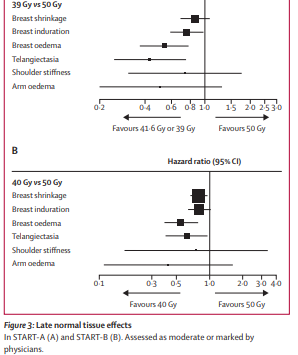Because they haven't been directly compared to one another? The BED of 2.66 x 16 is closer to 50/2 than 2.67 x 15.
I like Canadians more than I like the British. Canadians have given us Palma and the Toronto Raptors. UK has given us Jayant Vaidya and Brexit.
I find myself thinking that folks in the UK are driven by a perverse interest to minimize number of fractions at all costs, so as to the cut the costs to their failing NHS system, and they want us all to be on their level of dissatisfaction of lives as doctors. Beyond START, there's FAST and now FAST FORWARD.
Canadians seem to be less so in that vein, and more interested in expanding indications for radiation or more technical forms of RT (see Palma, Arjun Sahgal, etc), while the Brits just seem to be less, and less, and less. To the point where they seem less interested in the science and more towards pushing the agenda to fewest treatments possible (see the cosmesis data from FAST-FORWARD 5-year data)


